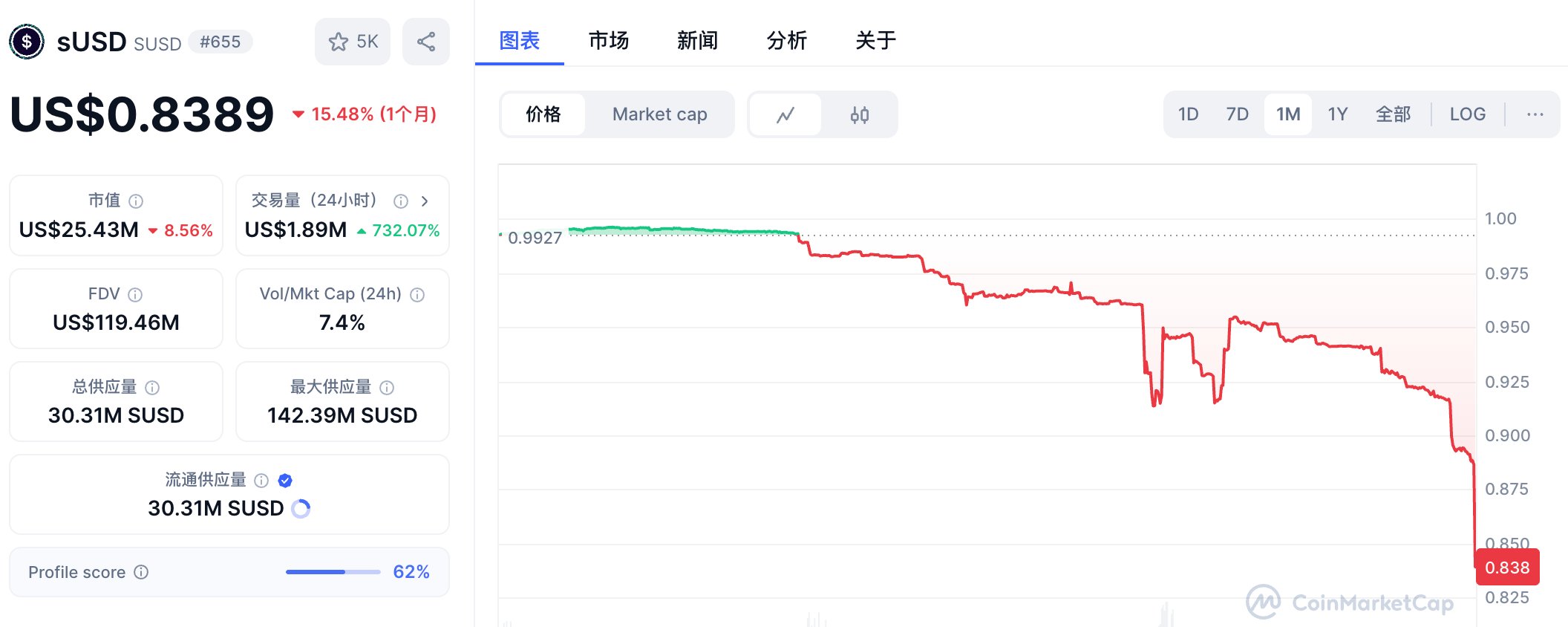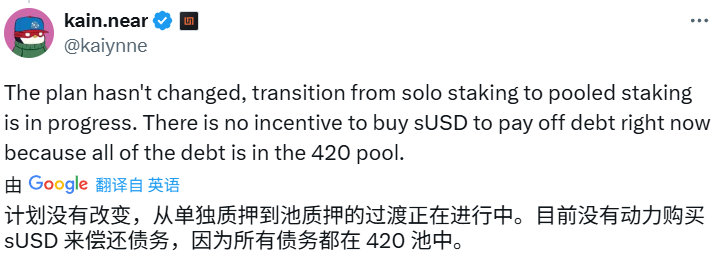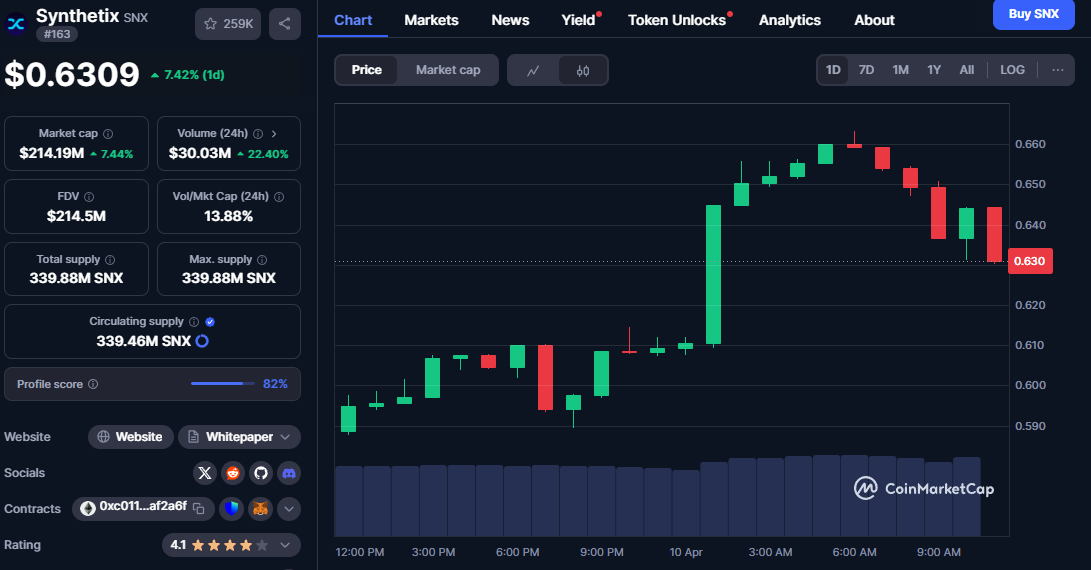This issue stems from the transitional period caused by the SIP-420 proposal, which has temporarily impaired the anchoring repair capability of sUSD.
Written by: Oliver, Mars Finance
The core stablecoin of the Synthetix ecosystem, sUSD, has recently fallen into a de-pegging crisis. As of April 9, 2025, its price dropped to approximately $0.8388, deviating more than 16% from the theoretical peg of $1, attracting significant market attention. This crisis began on March 20 and has lasted for over 20 days, with the degree of de-pegging continuing to expand. Meanwhile, the native token of Synthetix, SNX, has risen against the trend, with a daily increase of 7.5%, reflecting complex market sentiments. Synthetix founder Kain Warwick (@kaiynne) attributed the de-pegging to the transitional pains of the mechanism adjustment and revealed that the protocol has sold 90% of its ETH position and increased its SNX holdings in response.

Event Summary: Gradual Deterioration of De-pegging
The de-pegging of sUSD did not happen overnight. On March 20, 2025, its price first showed a slight deviation, initially not raising widespread alarm. However, over time, the fluctuations gradually evolved into a downward trend. By April 9, CoinMarketCap data showed that the price of sUSD had fallen to $0.8388, more than 16% below the pegged value. This prolonged de-pegging, lasting over 20 days, not only exceeded the expected time span but also far surpassed the market's conventional tolerance for stablecoins, indicating the deep complexity of the issue.

Kain Warwick explained on the X platform that the de-pegging is an expected side effect of the implementation of the SIP-420 proposal. This proposal aims to optimize the SNX staking mechanism and capital efficiency by introducing a centralized debt pool (the "420 Pool"), but the transition between the old and new mechanisms has temporarily disabled the anchoring repair capability of sUSD. He candidly stated that at the current stage, "there is no incentive for users to buy sUSD to repay debts," and the imbalance of supply and demand has become a direct driver of the price decline. Additionally, while the strategy of selling 90% of ETH positions and increasing SNX holdings aims to strengthen internal support, it may have weakened the system's liquidity and external stability foundation, adding more uncertainty to the market.
Root Causes of De-pegging: The Intersection of Mechanism Transformation and Market Feedback
The cause of this de-pegging is not singular but rather a result of the intertwining of mechanism adjustments and market behavior, presenting multiple dimensions of challenges.
The implementation of SIP-420 is the core trigger of the crisis. The stablecoin mechanism of Synthetix relies on the over-collateralization of SNX, where users mint sUSD by staking SNX and bear the volatility risk of the system's debt pool. Under the old mechanism, a collateralization rate of up to 750% and debt repayment incentives maintained the stability of sUSD. However, SIP-420 shifted the individual staking model to a centralized debt pool, attempting to enhance the attractiveness of SNX staking. This transformation theoretically injects long-term potential into the ecosystem, but during the transition period, it disrupted the existing balance. Warwick admitted that the new mechanism is not yet fully mature, and the old anchoring repair function has been temporarily shelved, causing sUSD to lose its self-regulating grip.
Market behavior feedback further amplified the de-pegging effect. Information from the X platform indicates that some users concentrated on exchanging sUSD for USDT or USDC on decentralized exchanges like Curve, quickly exhausting the liquidity pool's balance due to selling pressure. For example, in Curve's DAI-USDC-USDT-sUSD pool, the proportion of sUSD once spiked unusually, reflecting a decline in market confidence in stability. With a market cap of only $25 million, sUSD has weak liquidity, and any concentrated selling could trigger significant slippage, leading to further price deviation from the pegged value.
Adjustments at the protocol level have also brought unexpected side effects. The decision to sell 90% of ETH and increase SNX holdings, while strengthening SNX's dominant position in the ecosystem, has reduced the system's diversified support. ETH, as a widely recognized collateral, may have weakened external trust in sUSD with its exit, while the volatility of SNX has increased the concentration of risk. When SNX prices rise, this strategy may boost confidence, but against the backdrop of ongoing de-pegging, it casts a shadow over the repair process.
Historical Comparison
The de-pegging of sUSD is not the first occurrence. Looking back to May 16, 2024, sUSD fell to $0.915 due to a whale selling sBTC for sUSD, resulting in a de-pegging of about 8.5%. At that time, insufficient liquidity in the Curve pool, combined with MEV arbitrage bots' attacks, led to a brief loss of price control. Synthetix quickly took action by adding collateral such as ETH, BTC, and USDC to boost confidence and providing liquidity incentives in Velodrome and Curve, successfully re-pegging to $1 after 11 days. That de-pegging was essentially an external shock, with the mechanism itself remaining intact and a clear and efficient repair path.
In contrast, the de-pegging in 2025 presents entirely different characteristics. This crisis stems from internal mechanism adjustments of SIP-420 rather than a singular external sell-off, significantly increasing the complexity of the issue. The 2024 de-pegging lasted 11 days with an 8.5% drop, while the current situation has exceeded 20 days with a drop of over 16%, indicating the severity and persistence of the problem. Furthermore, the response in 2024 relied on liquidity incentives and diversified collateral, while the strategy in 2025 leans more towards internal adjustments (such as selling ETH and increasing SNX), with short-term effects yet to be seen. This suggests that the experiences of 2024 cannot be directly applied, and the difficulty of repair is far greater than before.
Feasibility Analysis of Bottom Fishing for sUSD
Currently, the price of sUSD hovers around $0.84. For investors, is bottom fishing and waiting for a re-peg feasible? The experience from 2024 provides some insights. At that time, sUSD rebounded from $0.915 to $1, with bottom fishers earning about 9% within two weeks, with the key to success being rapid incentive measures and the short-lived nature of external shocks. Now, with a lower price ($0.84), the potential return is higher (about 19%), but the risks have also increased.
Favorable factors cannot be ignored. The 7.5% increase in SNX reflects that market confidence in Synthetix has not collapsed, and the team's positive statements and debt relief plans also inject hope for repair. With a small market cap, sUSD has low capital demand; if the protocol introduces incentives, small buy orders could push the price up. However, the risks are also significant. The de-pegging has lasted over 20 days, with an unknown duration; if the adjustment of the new mechanism is delayed, the repair could take months. Selling pressure remains, and the imbalance in the Curve pool may further depress prices, while the loss of user confidence could weaken demand.

For example, with $100,000, buying about 119,000 sUSD at $0.84 could yield a profit of $19,000 if it re-pegs to $1, resulting in a 19% return. However, it is advisable to set a stop-loss line (e.g., $0.75) and closely monitor protocol announcements. If Synthetix introduces incentives similar to those in 2024, the chances of successful bottom fishing will increase significantly; if the price stabilizes and SNX continues to rise, small positions can be built. Compared to the low-risk window of 2024, this opportunity offers higher returns but comes with greater uncertainty.
Market Reactions and SNX's Anomalies
Despite sUSD being deeply mired in de-pegging, SNX recorded a 7.5% single-day increase on April 9, which is striking. The optimistic market sentiment may stem from expectations of long-term benefits from SIP-420. If the new mechanism is successfully implemented, it could enhance SNX's staking rewards and ecological status, boosting Synthetix's competitiveness in the DeFi space. Warwick's mention of the "Debt Jubilee" debt relief plan may also inject confidence into investors, suggesting that the clearing of historical debts will lighten the system's burden.
Community reactions are polarized. On the X platform, some users worry that sUSD may fall into a "death spiral," questioning the rationality of the mechanism adjustments; while others believe that the $25 million market cap of sUSD has limited impact, and the rise of SNX is the true reflection of market confidence. Professional analysis institutions like The Merkle News point out that the risks of the transitional period of SIP-420 are underestimated, but SNX's performance shows that Synthetix still has the potential for a comeback.
Summary
From an industry perspective, the de-pegging of sUSD has relatively limited impact. Its $25 million market cap is insignificant in the stablecoin market, far less than the scale of USDT or USDC, resulting in a minor chain reaction in the DeFi ecosystem. However, for Synthetix internally, prolonged de-pegging may undermine user trust. If liquidity pool funds continue to flow out, the practicality of sUSD will be limited, further weakening its position in synthetic asset trading.
In the short term, exacerbated de-pegging may lead to more sell-offs, putting further pressure on prices. However, the resilience of SNX has bought time for the protocol. If the new mechanism can stabilize in the coming weeks, combined with the debt relief plan, sUSD still has the potential to re-peg. In the long term, Synthetix needs to learn from this crisis, optimize stablecoin design, and avoid similar pains in the future. The success or failure of mechanism adjustments will determine whether it can establish a foothold in the fiercely competitive DeFi market.
Unlike the external shocks of 2024, the endogenous nature of this crisis makes its repair path more tortuous. The Synthetix team needs to tackle both mechanism optimization and market confidence rebuilding to turn risks into opportunities. For investors, the $0.84 sUSD represents both a risk exposure and a potential opportunity. Whether bottom fishing or waiting, closely monitoring the protocol's subsequent dynamics will be key. In this de-pegging storm, the future direction of Synthetix is worth continuous tracking.
免责声明:本文章仅代表作者个人观点,不代表本平台的立场和观点。本文章仅供信息分享,不构成对任何人的任何投资建议。用户与作者之间的任何争议,与本平台无关。如网页中刊载的文章或图片涉及侵权,请提供相关的权利证明和身份证明发送邮件到support@aicoin.com,本平台相关工作人员将会进行核查。




